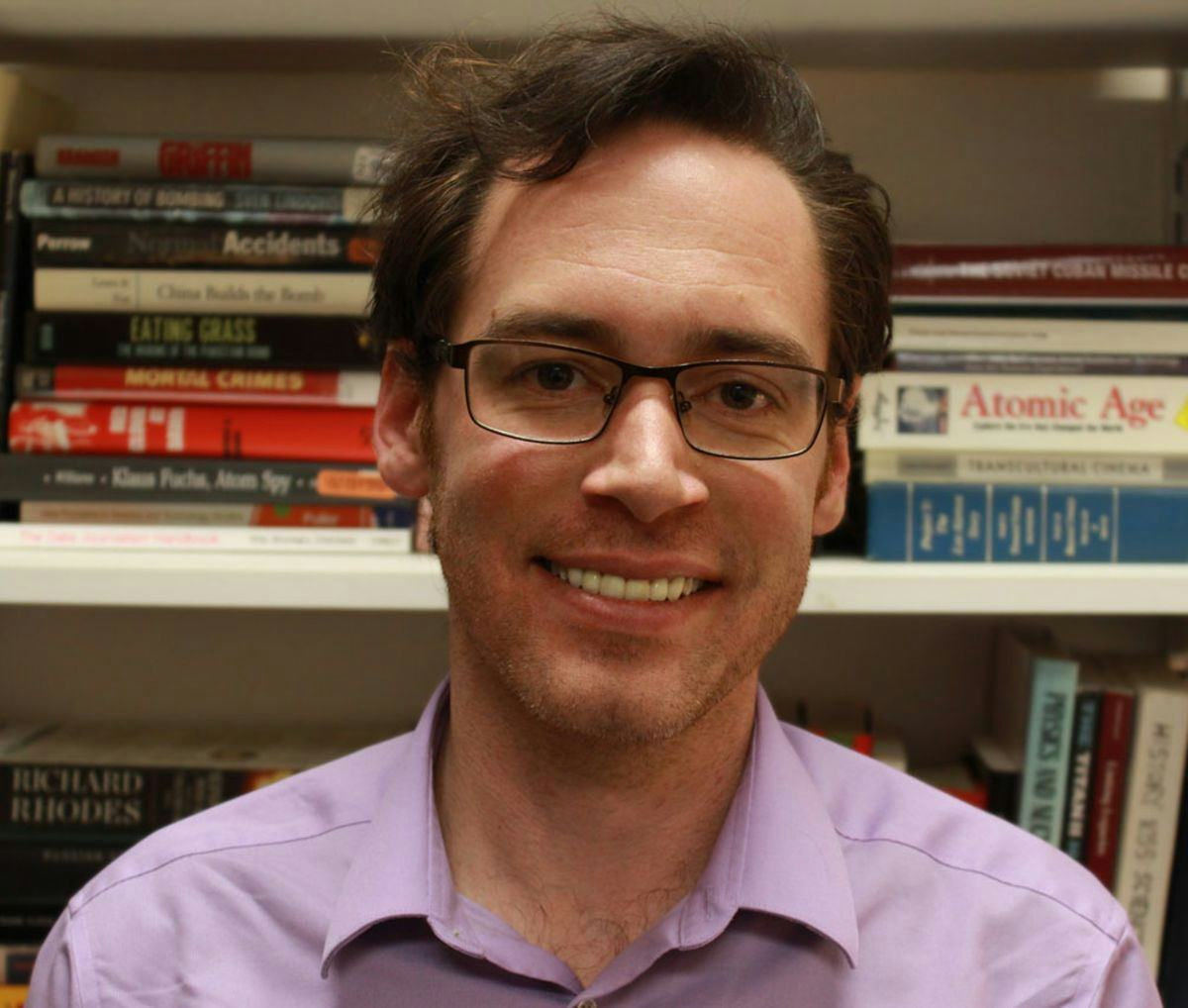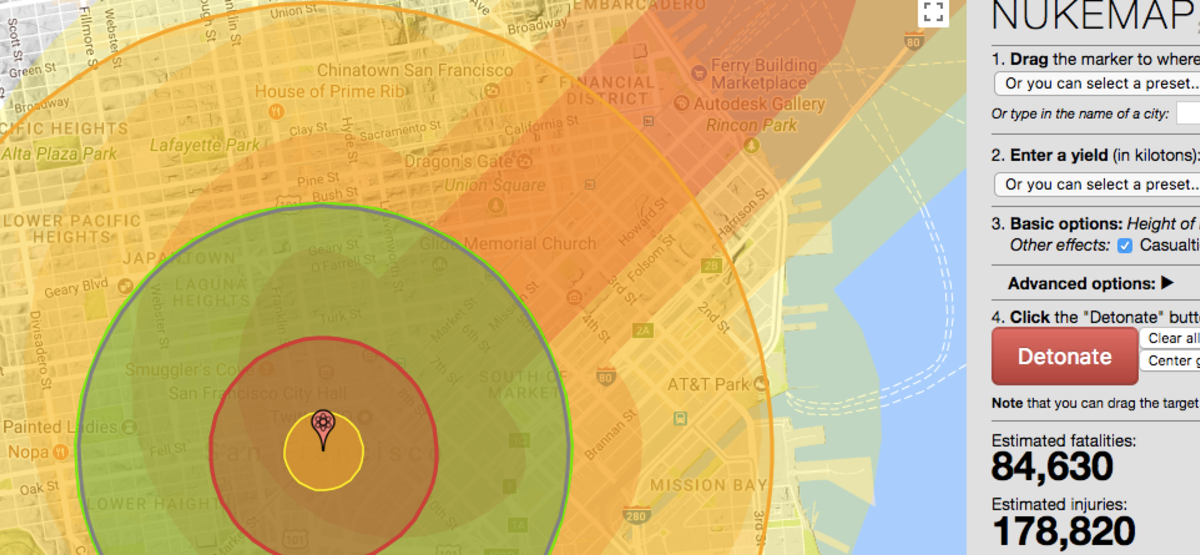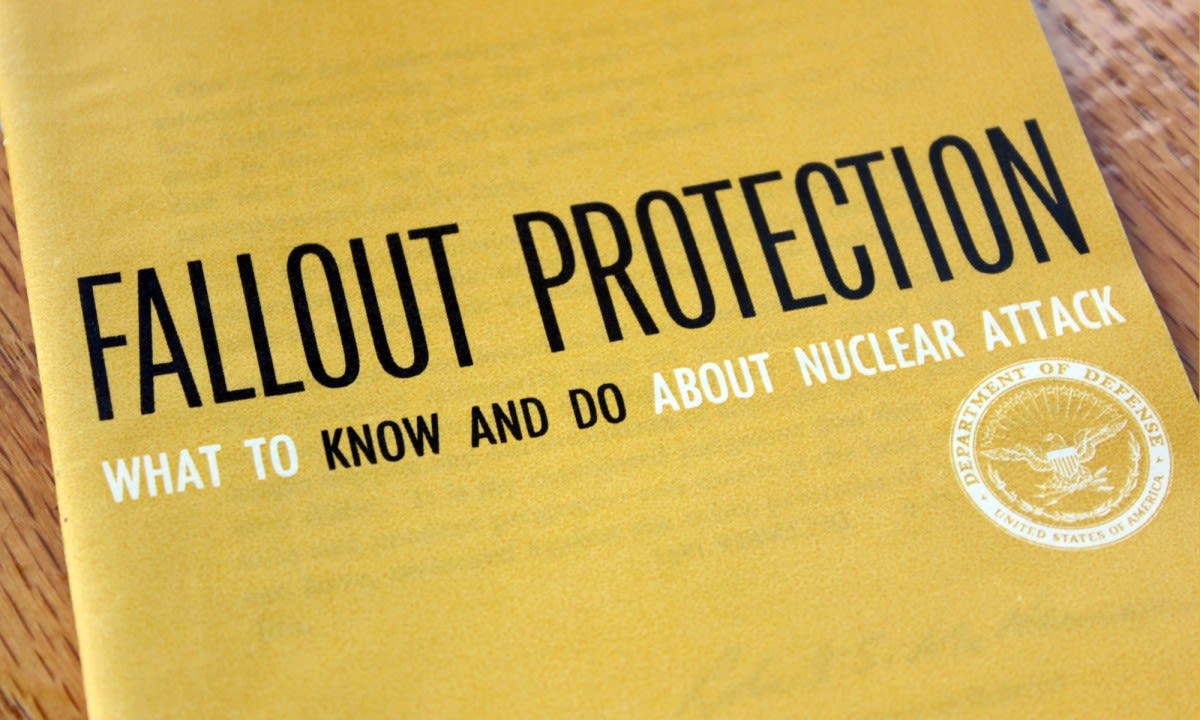Stevens’ Nuclear Expert Talks Oppenheimer, Trinity Test, Fallout, Builds Tools to Simulate Bomb and Missile Effects
Leading nuclear-history expert Alex Wellerstein fleshes out Manhattan Project, mines public data to illustrate the destructive potential of global weapons
Russia's 2022 invasion of Ukraine rekindled fears about both long-range nuclear weapons and shorter-range, non-nuclear missiles. And the Hollywood blockbuster film Oppenheimer captures the high drama and moral weight of atomic-bomb design during World War II, further piquing curiosity about nuclear weapons.
How did America actually design, test and then deploy its deadly pair of atomic bombs in Japan?
Are Russian, Chinese and North Korean missiles accurate enough to target and strike American cities?
And what kind of damage would a nuclear detonation or conventional missile wreak upon New York, Los Angeles, Washington or Kyiv if it struck home?
Stevens professor and historian of science Alex Wellerstein knows (or can guess) many of the answers, thanks to a career spent immersed in the murky history of the American nuclear-weapons program and public but largely unexplored data collected by the Department of Defense on weapons collateral.
Designing Armageddon: Oppenheimer, the Trinity test, Hiroshima
Wellerstein has devoted his career to unearthing the nation’s nuclear history, some of it secret and some of it public but squirreled deeply away in Department of Defense archives. He authored a 2021 book, Restricted Data: The History of Nuclear Secrecy in the United States, published by the University of Chicago Press, and works to shed light on the nuclear era by fleshing out the people, policies, and science that came together in America’s Manhattan Project.
Speaking to The New York Times about the crucial 1945 Trinity test of the atom bomb in the New Mexico desert, he recently noted how fallout reached nationwide but wasn’t considered important at the time by the government.
“They were thinking about acute risk in the areas around the immediate detonation site,” Wellerstein told the Times. “They were not really thinking about effects of low doses on large populations, which is exactly what the fallout problem is.”
Speaking with Time at length about chief Manhattan Project scientific director Robert Oppenheimer, subject of the 2023 film, he noted how “a lot of people know that he was the father of the atomic bomb; a lot fewer people know that he was deeply involved with many discussions about maybe even the abolition of nuclear weapons but also how you use nuclear weapons in a modern Cold War.”
The nuclear weapon-design effort, added Wellerstein, was much more difficult scientifically than was originally believed. But Oppenheimer, as he worked, pushed to design more destructive weaponry in order to deter future potential nuclear wars.
He has also written about the ways in which the U.S. government did (or did not) warn Japan about the twin atomic bombs it eventually dropped on the cities of Hiroshima and Nagasaki, killing and poisoning hundreds of thousands of Japanese.
Public data, powerfully programmed
In another effort to help understand the terrible power of nuclear weaponry, Wellerstein created and still manages two software simulation tools that test scenarios and depict the destructive force of both the world's nuclear and non-nuclear arsenals.
One tool he created, NUKEMAP, works in any web browser and can graphically simulate a nuclear detonation anywhere on the planet. At the click of a "detonate" button, the software produces simulations and visualizations of blast zones, mushroom clouds and fallout plumes spreading through the air — plus fatality and injury estimates — atop digitally mapped renderings of cities.
Users can experiment with a wide range of nuclear weapons, from small "backpack bombs" to large-scale thermonuclear weapons such as a hydrogen bomb, and more than 220 million "detonations" have been simulated since Wellerstein unveiled it a decade ago.
He says web traffic to the site increased ten-fold during the initial phases of Russia's invasion of Ukraine, to as many as 150,000 visits daily, likely due to public concerns about international nuclear war.
"Being told a certain nuclear weapon emits 500 rem of radiation over a given radius means little to the average person," explains Wellerstein. "But when you pair that with an illustration of a cloud spreading over a city they live in, along with a qualitative description of the effects and casualties, the picture suddenly becomes much clearer."
A companion tool, MISSILEMAP, does much the same for long-range missiles. Users select launch sites, missiles and targets and the accuracy of each missile, the explosive power of its warhead and the odds of hitting its target are instantly calculated and displayed.
With regard to a nation like North Korea, "we still don’t know exactly what North Korea’s missiles are capable of," Wellerstein explains. "But you can plug some fairly conservative numbers into MISSILEMAP and see that hitting Guam accurately would be somewhat difficult, but not impossible, while hitting Los Angeles is easy — if they have the range."
A North Korean missile aimed at San Francisco, for instane, could potentially kill or injure at least a quarter-million residents and obliterate much of the city's downtown district according to the MISSILEMAP and NUKEMAP simulations.
While Wellerstein integrated the data and created the visualizations for the two tools, he didn't need to create the math from scratch. That had already been done by the U.S. government decades ago, then later declassified as open data. When he discovered their existence, Wellerstein dove into defense archives and obtained painstaking blast-zone research derived from postwar studies of detonations at Hiroshima, Nagasaki, the Nevada Test Site and in the Marshall Islands.
"Those Cold War calculations were daunting for the computing machines of the 1960s, but now easily run in a modern web browser," he explains.
Next, Wellerstein programmed the calculations into JavaScript to run and graphically depict each simulation. While some of the work was straightforward, some equations required complex translation to the digital environment. (Wellerstein teaches "Visualizing Society," a Stevens undergraduate course where students learn to develop dynamic, socially relevant web visualizations using similar methods.)
The resulting JavaScript library includes dozens of equations that factor in blast pressure, thermal and ionizing radiation, long-range fallout and other data, modeling various weapons' power and fallout potential by integrating population, weather and other data for global cities.
Missile tool models long-range attacks
MISSILEMAP works with more complicated calculations, assumptions and defense concepts such as Great Circle trajectories, Circular Error Probable (a measure of missile accuracy) assumptions and the Single Shot Probability of Kill, a measure of the likeliness of a target to be destroyed by a launched missile.
A location's coordinates are entered, producing a missile's maximum target range superimposed upon a world map. The resulting data can also be exported back to NUKEMAP to further visualize the consequences of a successful missile launch on a given city.
"Again, this is all public data," notes Wellerstein. "All models used in the creation of these tools are adapted from government research that was paid for by U.S. taxpayers. It's good to put them to public use again."
The simulations of destruction and estimated casualty figures can be shocking, and have attracted broad attention. Media from The New York Times and Los Angeles Times to The Atlantic, Popular Science and The Telegraph — as well as defense experts and commentators such as former U.S. Defense Secretary William J. Perry and talk-show host Jimmy Kimmel — have referenced or published images from Wellerstein's work.
The perspective these visualizations give, says Wellerstein, is striking.
"In the NUKEMAP simulation, a Hiroshima-type bomb detonated in Manhattan punches out the center of the downtown, yes, but observers only a mile or two away mostly experience shattered windows," he notes. "A hydrogen bomb, however, destroys the entire metro area, with tremendous casualties and a huge mushroom cloud."
His own students often audibly gasp as they see the visualizations unfolding on screen, understanding in a visceral way the true gravity of the modern nuclear threat landscape.
"Even a small modern nuclear weapon is many times more powerful than the largest weapons ever used in World War II," notes Wellerstein. "It's my hope that NUKEMAP and MISSILEMAP help everyone begin more serious and careful conversations about the real power of these weapons, not only among the public but among national and international leaders."
The work is timely: a 2020 survey by Stevens political scientist Kristyn Karl and psychology professor Ashley Lytle found Americans belive nuclear war is a 50/50 possibility in their lifetimes, an exceptionally high number historically.
A recent related project, headed by Wellerstein and Karl and supported by the Carnegie Corporation of New York, has worked to develop more effective communications strategies aimed at conveying sound civil defense practices — how to best evacuate or shelter during and after a proximate nuclear detonation, for example — using our modern forms of digital media, social media, art and graphic design. Some of the work was presented at a 2019 exposition, The Bomb and You.
"Most of the time, we don’t think or talk about nuclear weapons," concludes Wellerstein, "until there’s a period of crisis. And then we become extremely anxious and want to know more."
MAJOR MEDIA COVERAGE
THE NEW YORK TIMES
Trinity Nuclear Test's Fallout Reached 46 States, Canada and Mexico, Study Finds
THE WASHINGTON POST
How Oppenheimer weighed the odds of an atomic bomb test ending Earth
TIME
Why Oppenheimer's Nuclear Fears Are Just as Relevant Today
SCIENTIFIC AMERICAN
What Was the Manhattan Project?
NEWSWEEK
Nuclear Bomb Simulator Used 9 Million Times Since Russia Invaded Ukraine
THE SEATTLE TIMES
Washington Stopped Planning for a Nuclear War in 1984. Should We Start Now?





